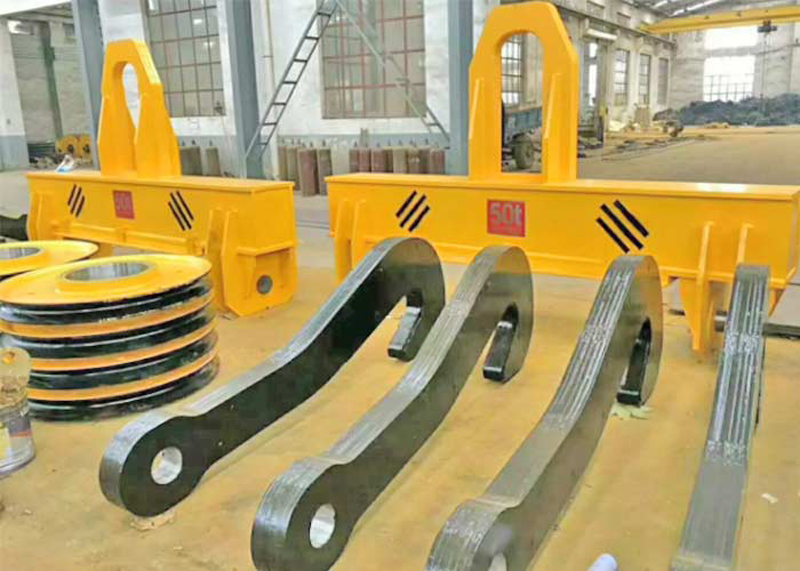The crane hook. It’s the seemingly simple, yet absolutely critical, point of connection between your crane and its load. A failed Kranhaken doesn’t just mean downtime; it can lead to catastrophic accidents, Verletzungen, fatalities, and significant property damage. Regular and thorough inspection of crane hooks isn’t just good practice – it’s a non-negotiable safety imperative.
This guide outlines the essential steps for a proper crane hook inspection, covering both frequent pre-use checks and more detailed periodic inspections. Always adhere to the manufacturer’s specific instructions and relevant safety regulations (Wie OSHA, ASME B30.10, ISO 9927-1, or local equivalents) for your equipment.

Prevents Failure: Hooks are subjected to immense stress, bending, and wear. Fatigue cracks or deformation can develop over time.
Identifies Wear & Damage: Normal use causes wear on the saddle, Schaft, und verriegeln (if equipped). Damage can also occur from overload, Auswirkungen, or environmental factors.
Ensures Load Security: A deformed hook or malfunctioning latch can allow the load to slip or detach unexpectedly.
Einhaltung: Regular documented inspections are typically required by law and insurance policies.
Pre-Use / Häufige Inspektion: Performed daily or before each shift by the operator or designated personnel. Quick visual and functional check.
Periodic / Regelmäßige Inspektion: Conducted monthly, quarterly, or annually (as defined by regulations, Hersteller, and usage severity) by a competent and qualified inspector. More detailed, may involve measurements and cleaning.
Comprehensive / Major Inspection: Detailed disassembly and examination, often requiring specialized personnel and NDT (Nicht-zerstörerische Tests), typically annually or as specified.

Isolate the Crane: Lockout/Tagout (LOTO) the crane’s power source. Ensure it cannot be energized.
Lower the Hook: Position the hook block safely at ground level or a designated inspection area.
Clean the Hook: Remove excessive dirt, grease, or paint build-up that could hide defects. A wire brush is often useful. Caution: Don’t remove protective lubricants in wear areas unless specified for inspection.
Gather Tools: Good lighting (flashlight!), inspection mirror, magnifying glass, calipers or hook gauges (to measure wear/deformation), wear gauge for the latch (gegebenenfalls), and documentation forms.
Risse: Der #1 critical defect. Examine the ENTIRE hook meticulously, paying special attention to high-stress areas:
Inside the “Saddle” (Bowl/Throat): The curved inner surface where the load sits. Use a mirror to see all areas. Look for ANY hairline cracks, especially radiating from the inner surface.
Schaft (Area below the Saddle): Inspect both sides and the top where it meets the swivel or nut.
Hook Tip (Punkt):
Base of the Hook (Where shank meets the eye/shim/nut): A prime location for fatigue cracks.
Tragen:
Saddle (Halsöffnung): Measure the wear depth. Compare to the original dimension (often stamped on the hook or in manuals). Critical: Wear exceeding 10% (or manufacturer limit, oft 5-15%) of the original throat opening diameter usually mandates replacement. Use hook gauges or calipers.
Hook Tip: Excessive wear can reduce strength and affect latch function.
Verformung (Biegen, Twisting):
Twist: Look down the shank towards the tip. The tip should be centered within the shank. Any noticeable twist is unacceptable.
Bend/Opening: Compare the actual hook opening (distance between tip and shank) to the original specification. Opening increasing beyond 15% (or manufacturer limit, oft 5-15%) is dangerous. Use gauges or calipers.
Straight Shank: The shank should be straight, not bent or bowed.
Korrosion & Pitting: Severe corrosion or deep pitting significantly weakens the hook. Light surface rust might be cleaned and monitored, but significant pitting requires evaluation by a qualified person. Beware of corrosion under paint.
Gouges, Nicks, & Grooves: Deep surface damage acts as a stress concentrator, potentially leading to cracks. Assess depth and location.
Paint Condition: Peeling, flaking, or blistering paint could indicate underlying corrosion. It can also hide cracks. Areas needing repainting should be cleaned and inspected first.
3. Functional Inspection (For Hooks with Latches):
Latch Presence & Type: Ensure the correct type of latch (spring-loaded, gravity, usw.) is present and intact as designed.
Latch Operation:
Spring Latches: Should move freely and snap back positively into the closed position over the hook tip when released. Check spring tension.
Gravity Latches: Should swing freely and cover the tip reliably under gravity.
Latch Wear: Inspect the latch contact surface with the hook tip for excessive wear or deformation. Measure wear against specifications if possible.
Latch Security: The latch must effectively prevent slings or hardware from accidentally slipping off the tip when closed. Verify it cannot be easily forced open under light pressure.
4. Attachments & Fittings:
Hook Nut/Collar: Check for tightness (no rotation), Risse, Verformung, und Korrosion. Ensure it’s properly seated.
Swivel Mechanism (gegebenenfalls): Check for smooth rotation without binding, excessive play, or visible damage. Listen for grinding noises when turning manually.
Safety Latch Pins/Retainers: Ensure they are present and secure.
Hook Block Sheaves: Inspect for wear, Risse, and smooth rotation (though this is part of block inspection, it’s often done concurrently).
5. Dokumentation:
Record Findings: Document every inspection (date, inspector, crane ID, hook ID), noting any defects found, measurements taken, and actions taken (Z.B., “Passed,” “Monitor wear at location X,” “Removed from service”).
Tagging: If a hook fails inspection, it MUST be immediately removed from service. Tag it clearly “DO NOT USE” or “DEFECTIVE” and follow procedures for repair/replacement by qualified personnel. Never weld or attempt to straighten a damaged hook! Replacement is the only safe option for critical defects.

Pro Tip: When in doubt about the severity of a defect, REMOVE THE HOOK FROM SERVICE and consult a qualified crane inspector or engineer. Never gamble with hook integrity.


Inspecting a crane hook is a fundamental responsibility for anyone involved in crane operations. By incorporating thorough pre-use checks and diligently following scheduled periodic inspections using this checklist, you proactively identify potential hazards before they lead to disaster. Remember, a few minutes spent carefully examining that hook could save lives, prevent injuries, and avoid costly accidents. Make hook inspection a non-negotiable part of your daily safety routine.
Wir schätzen Ihr Feedback! Bitte füllen Sie das folgende Formular aus, damit wir unsere Dienste auf Ihre spezifischen Anforderungen anpassen können.


Klicken Sie auf die Schaltfläche, um Produktinformationen und Angebote auf WhatsApp zu erhalten.
Holen Sie sich Zitat
Neueste Kommentare